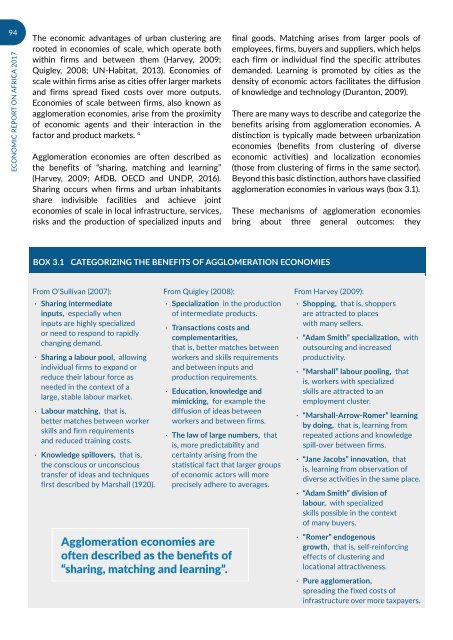URBANIZATION AND INDUSTRIALIZATION
Economic%20Report%20on%20Africa%202017%20UNECA
Economic%20Report%20on%20Africa%202017%20UNECA
You also want an ePaper? Increase the reach of your titles
YUMPU automatically turns print PDFs into web optimized ePapers that Google loves.
94<br />
ECONOMIC REPORT ON AFRICA 2017<br />
The economic advantages of urban clustering are<br />
rooted in economies of scale, which operate both<br />
within firms and between them (Harvey, 2009;<br />
Quigley, 2008; UN-Habitat, 2013). Economies of<br />
scale within firms arise as cities offer larger markets<br />
and firms spread fixed costs over more outputs.<br />
Economies of scale between firms, also known as<br />
agglomeration economies, arise from the proximity<br />
of economic agents and their interaction in the<br />
factor and product markets. 4<br />
Agglomeration economies are often described as<br />
the benefits of “sharing, matching and learning”<br />
(Harvey, 2009; AfDB, OECD and UNDP, 2016).<br />
Sharing occurs when firms and urban inhabitants<br />
share indivisible facilities and achieve joint<br />
economies of scale in local infrastructure, services,<br />
risks and the production of specialized inputs and<br />
final goods. Matching arises from larger pools of<br />
employees, firms, buyers and suppliers, which helps<br />
each firm or individual find the specific attributes<br />
demanded. Learning is promoted by cities as the<br />
density of economic actors facilitates the diffusion<br />
of knowledge and technology (Duranton, 2009).<br />
There are many ways to describe and categorize the<br />
benefits arising from agglomeration economies. A<br />
distinction is typically made between urbanization<br />
economies (benefits from clustering of diverse<br />
economic activities) and localization economies<br />
(those from clustering of firms in the same sector).<br />
Beyond this basic distinction, authors have classified<br />
agglomeration economies in various ways (box 3.1).<br />
These mechanisms of agglomeration economies<br />
bring about three general outcomes: they<br />
Box 3.1 CATEGORIZING THE BENEFITS OF AGGLOMERATION ECONOMIES<br />
From O’Sullivan (2007):<br />
• x Sharing intermediate<br />
inputs, especially when<br />
inputs are highly specialized<br />
or need to respond to rapidly<br />
changing demand.<br />
• x Sharing a labour pool, allowing<br />
individual firms to expand or<br />
reduce their labour force as<br />
needed in the context of a<br />
large, stable labour market.<br />
• x Labour matching, that is,<br />
better matches between worker<br />
skills and firm requirements<br />
and reduced training costs.<br />
• x Knowledge spillovers, that is,<br />
the conscious or unconscious<br />
transfer of ideas and techniques<br />
first described by Marshall (1920).<br />
From Quigley (2008):<br />
• x Specialization in the production<br />
of intermediate products.<br />
• x Transactions costs and<br />
complementarities,<br />
that is, better matches between<br />
workers and skills requirements<br />
and between inputs and<br />
production requirements.<br />
• x Education, knowledge and<br />
mimicking, for example the<br />
diffusion of ideas between<br />
workers and between firms.<br />
• x The law of large numbers, that<br />
is, more predictability and<br />
certainty arising from the<br />
statistical fact that larger groups<br />
of economic actors will more<br />
precisely adhere to averages.<br />
Agglomeration economies are<br />
often described as the benefits of<br />
“sharing, matching and learning”.<br />
From Harvey (2009):<br />
• x Shopping, that is, shoppers<br />
are attracted to places<br />
with many sellers.<br />
• x “Adam Smith” specialization, with<br />
outsourcing and increased<br />
productivity.<br />
• x “Marshall” labour pooling, that<br />
is, workers with specialized<br />
skills are attracted to an<br />
employment cluster.<br />
• x “Marshall-Arrow-Romer” learning<br />
by doing, that is, learning from<br />
repeated actions and knowledge<br />
spill-over between firms.<br />
• x “Jane Jacobs” innovation, that<br />
is, learning from observation of<br />
diverse activities in the same place.<br />
• x “Adam Smith” division of<br />
labour, with specialized<br />
skills possible in the context<br />
of many buyers.<br />
• x “Romer” endogenous<br />
growth, that is, self-reinforcing<br />
effects of clustering and<br />
locational attractiveness.<br />
• x Pure agglomeration,<br />
spreading the fixed costs of<br />
infrastructure over more taxpayers.


